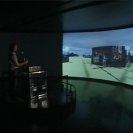PLACE-Urbanity is based on the earlier prototype of the panoramic interactive paradigm as explored in PLACE — A User’s Manual commissioned by and premiered at Neue Galerie am Landesmuseum Joanneum, Graz, Austria in 1995. In this prototype the viewer interactively rotated a projected image around a circular screen to explore a virtual three-dimensional space that was constituted by an emblematic constellation of panoramic photographic landscapes.
The new interactive video installation is based on the development of a 360-degree digital video recording system using 16 DV video cameras arranged in a ring and 16 DV recorders. Custom software allows these 16 simultaneous video recordings to be ‘stitched’ together in the post-production to form one ‘panoramic movie’ which is stored and accessed from a hard disc array.
In the installation the operator rotates his/her viewing window within the 360 degree cinematic space, which plays back at 25/30 fps. Parallel with this panoramic video recording technology, audio technology will be developed for panoramix audio recording, which combines surround ambient as well as discretely located sound sources. Custom software will dynamically mix and focus these 16/32 sound tracks in conjunction with the path of the operator’s view in the virtual environment. This new virtual landscape will be populated by cylinders of moving audio-visual data — a constellation of cinematic events that the viewer can visit and examine in whatever order s/he chooses. In other words, PLACE presents a modular interactive cinema, where two kinds of spaces are conjoined — the cinematically represented spaces, and the space of the virtual environment in which these cinematic spaces are geographically located.
Such a spatial conjunction also has major implications for the development of interactive narrative structures. On the one hand there is the set of autonomous narratives embodied in each of the panoramic video recordings. On the other hand there is the hyper-narrative of interactive relations and experiences that is effected by the viewer’s free journey within the virtual environment. Because this journey is, in effect, a process of viewer control of both the ‘camera’ and the ‘edit’ of the pre-recorded cinematic data, each performance will become a unique event. PLACE-Urbanity will explore the possibilities of this interactive cinematic landscape specifically in terms of urbanity, looking for significant scenes and events in the Australian urban fabric that become a quilt of telling relationships when conjoined in PLACE’s navigable environment.





